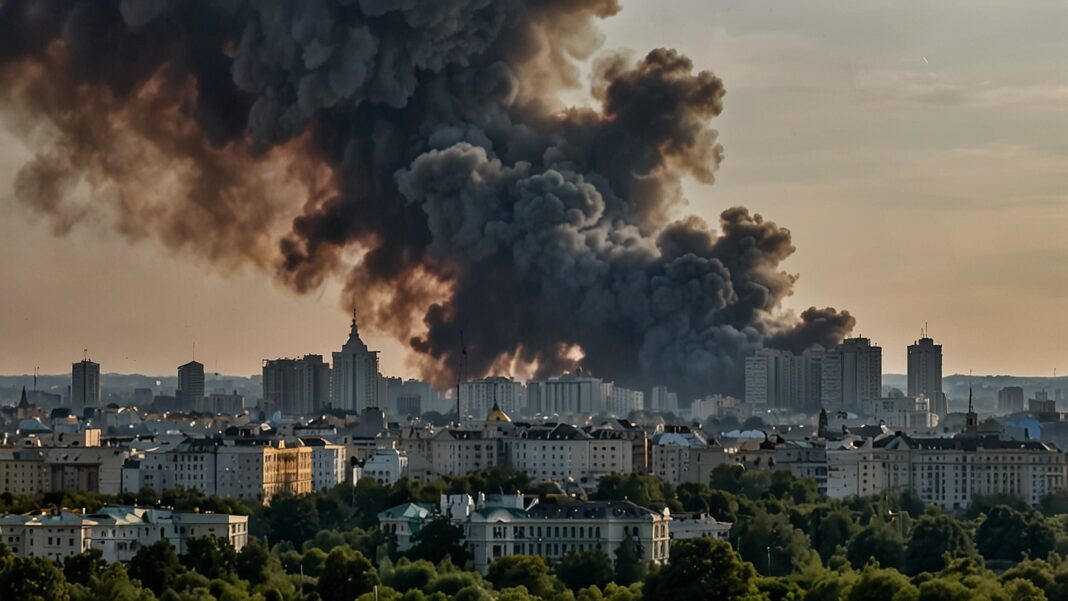In an unparalleled attack at the critical energy infrastructure in Ukraine, Russia fired 582 missiles and drones on Ukraine on August 30, 2025, one of the biggest air attacks of the conflict. Ukrainian President Volodymyr Zelensky denounced the attack as an attempt to undermine peace through brutality, telling the international community to pressure Moscow with increased sanctions.
Killing at least 23 people in Kyiv alone and injuring dozens in other areas, the attack has propelled Europe into a new course of decisive action against Russia, taking up global headlines and search trends. The strike at dawn was directed at major energy infrastructure, such as power plants and substations; the intention was to leave Ukraine in the dark before winter.
Ukrainian air defences shot down 510 drones and 38 missiles. Still, the immense number of them overwhelmed some, with fires and structural damage reported in seven locations, and debris from damage hitting 21 others. The attack disrupted the power supply to hundreds of thousands of people, leaving hospitals reliant on generators and raising concerns about an extended blackout.
Devastation in Kyiv and Beyond
The capital of Ukraine, Kyiv, was severely damaged, along with residential premises and a European diplomatic mission, as a result of which the EU accused Russia of violating international law. In Zaporizhzhia, a single individual was killed and 24 more, including three children, were injured after the missiles hit civilian infrastructure.
The emergency crews fought all day and night to contain fires and to restore power, but the authorities warned that there would be severe disruption to heating and water supply with the falling temperatures. Addressing a safe place, Zelensky termed the attack a calculated strike in ongoing peace negotiations.
Treating a 40-kilometre buffer zone, he said, as outdated in the context of modern warfare, Russia uses negotiations to re-equip, and then to attack. In retaliation, Ukraine has retaliated with attacks on Russian oil refineries in Krasnodar and Syzran, sparking enormous fires and destabilising the fuel supply chain of Moscow. Such retaliatory strikes reveal the determination of Ukraine to strike against the economic lifelines of Russia amid the air attacks.
Europe’s Unified Response
On August 29, the attack took centre stage at an EU summit held in Copenhagen, where leaders promised to increase their support in Ukraine. Kaja Kallas, the Chief of EU foreign policy, stated that without compensation to cover Ukraine’s losses, the frozen Russian assets would not be released, worth 210 billion euros ($245.85 billion).
Only strength reacts with Putin, Kallas said, the harder the sanctions. Poland and the Baltic states pressed for the outright confiscation of assets to finance the defence of Ukraine, but France and Germany insisted on a system that would use only the profits, due to legal limitations.
European defence ministers had promised to provide more military support, including high-level air defence and the deployment of troops, to monitor any subsequent ceasefire. Thirty countries, including Japan and Australia, are organising to share the load with the U.S., pressing Europe to lead.
Simon Harris of Ireland requested more aggressive measures, and Dovile Sakaliene of Lithuania requested the immediate seizure of assets. The crisis brought more attention to the international sphere; the United Nations Security Council organised an emergency meeting to address the crisis.
European Commission President Ursula von der Leyen embarked on a visit to EU countries with Russian borders to organise more armoured units, such as those in Latvia. Her words can be interpreted as an indication that Europe is committed to Ukraine’s sovereignty and its potential entry into the EU, which is one of the trending topics on the Internet as people seek information on the conflict’s consequences.
Strategic Implications and Global Spotlight
The fact that the attack occurred during the stalemated peace negotiations is a stress factor in the Russian policy of attrition. Kremlin spokesperson Dmitry Peskov stated that President Vladimir Putin may meet Zelensky only after initial agreements, but Ukraine denies a buffer zone, which displays profound divisions.
Analysts caution that, unless Russia swiftly receives international action, it may continue to attack Ukraine’s infrastructure, thus continuing the war. The attack has generated a lot of online buzz with such terms as Russia-Ukraine attack 2025, Kyiv missile strike, and EU sanctions on Russia surging on Google.
The posts on social media sites such as X have been filled with messages criticising the actions of Russia and commending the standing of Ukraine. The controversy concerning frozen assets in the EU has been a trending topic as well, with the user typing in Russia frozen assets and Ukraine reparations to see the economic interests.
The issue of nuclear risks remains on the agenda, especially as the U.S. presidential transition approaches. The move to deploy peacekeeping forces and sanctions in Europe is an indication of a transition to more responsibility, particularly as the previous president, Donald Trump, disagreed with the involvement of U.S troops.
Zelensky demands that tough action be taken against supporters of the war in Russia, including banking and energy sanctions, which have reverberated throughout Europe and have led to online debates on global responsibility.
Ukraine’s Resilience Amid Crisis
In Kyiv’s streets, defiance shines through the devastation. A resident told reporters, “We will be back as usual, and social media echoed this with such hashtags as StandWithUkraine.
The magnitude and the timing of the attack have placed it among the leading stories, and news outlets, as well as search engines, prioritise news on the war. The world is on the edge of its seat as Ukraine prepares to face more attacks; the reaction of Europe will likely be the defining course of the war, and this will dominate global news feeds.
The August 30, 2025, incident has solidified this conflict as a moment in history and sparked colossal internet interest, putting this story near the top of Google trending. The crisis should be high on search engines, and newsfeeds and social media should be flooded with information, as it has a human cost, geopolitical implications, and calls to action.
